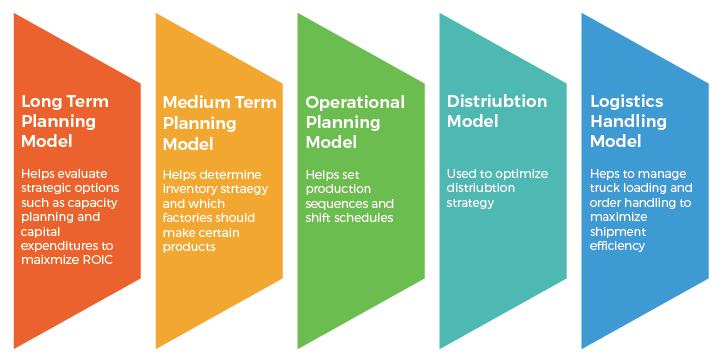To understand the challenge of making the move to prescriptive analytics, we look at real-world applications and, more importantly, how such capabilities can make your company more efficient and more profitable.
Check this out: Prescriptive analytics uses algorithms to create a flexible performance model of your business that can provide managers insights into the best decision to make in a given situation. It has the benefit of fully respecting the constraints and objectives of the business while also reporting the financial impact. That’s right. The dashboard chart below shows the types of business analytics and their role in planning and decision-making processes.
A Framework for Understanding the Value of Differing Types of Analytics From Gartner

This is when you realize that prescriptive analytics is not new. Manufacturers have been leveraging such tools to model and optimize functional processes for years. The algorithms (typically linear programming) help solve complex problems that have competing objectives and hundreds to thousands of constraints. Some of the questions that manufacturing managers can use prescriptive analytics to help answer include:
- What promotions should we run on what products to optimize the profitability of sales, rather than simply driving revenue?
- What orders should we prioritize to maintain service levels and optimize profits? How should we balance service levels with production constraints?
- Where should we manufacture which products? How can we best balance the tradeoffs between manufacturing, inventory, distribution and customer service levels?
- When should we reduce SKUs or introduce new products?
So what am I saying? As data analysis tools have evolved, the applications for prescriptive analytics have grown for a number of reasons. Let’s take a closer look.
1. Availability of more, higher quality data. Cleaner, more diverse and more easily integrated data is now available across business functions, enabling the entire value chain to be optimized.
2. Easier to use. Simpler interfaces make prescriptive analytics less of a “black box” solution that requires specialized knowledge to use. Managers can understand the “why” and “how” of optimization runs with simple, clean interfaces.
3. Greater sophistication. New decision-support tools can model highly complex problems with hundreds to millions of constraints and variables. Further, it’s easy to adjust assumptions and objectives for rapid what-if and scenario analysis.
4. Expanded focus on the business as a whole. Optimization models can now address larger enterprise-wide challenges and tradeoffs, including the financial impact of potential decisions.
Prescriptive Analytics Is Now in the Hands of Business Unit Leaders – Not Just Data Scientists
What’s more, any effective decision-support tool will be more beneficial if it’s understood and used by people at all levels of the organization. Most importantly, what matters most to business leaders is financial performance. In other words, prescriptive analytics models can now incorporate contribution margins, activity-based costing, and pro-forma financial statements to help leaders make the best possible business decisions.
Before we go another further, consider a North American consumer packaged goods manufacturer. The company is relatively integrated and develops, manufactures, and distributes most of the products it sells. It has built a number of prescriptive analytics models to help executives and managers make better financial and operational decisions.
Examples of the analytics models are outlined below. Some of the business benefits include higher throughput, significant cost reductions, and risk mitigation. The models enable managers to respond quickly to unforeseen circumstances with an optimized and feasible plan rather than making gut-feel decisions.

It all comes down to this. These two attributes (optimization and feasibility) are what have been missing from other decision-support tools that prescriptive analytics can provide.
- Optimized means that the plan maximizes profit across the company.
- Feasible means that it can readily be implemented.
- Both are necessary to identify and realize the potential of any recommended course of action.
Remember: this brief overview helps explain what prescriptive analytics is, why potential applications for manufacturers are expanding, and the challenges that these solutions can help solve.
How? By moving from information to optimization, your company can make the move to prescriptive analytics.

River Logic collaborated with TBM Consulting, a new solutions partner for River Logic, to develop this blog post. Nathan Goldstein, Vice President of Partners at River Logic, and Ken Koenemann, Vice President of Technology and Supply Chain at TBM consulting, collaborated to produce this blog post. TBM Consulting is and operations and supply chain consulting firm that helps clients leverage operational excellence, enabling technologies, and lean process rigor to dramatically enhance operational speed.






